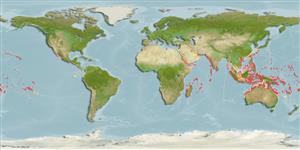Common names from other countries
>
Anguilliformes (Eels and morays) >
Ophichthidae (Snake eels) > Myrophinae
Etymology: Scolecenchelys: Greek, skolex = worm (1855) + Greek, enchlys, -yos = eel (Ref. 45335).
More on author: Bleeker.
Environment: milieu / climate zone / depth range / distribution range
Écologie
marin récifal; profondeur 0 - 30 m (Ref. 86942). Tropical; 32°N - 28°S
Indo-Pacific: widespread, from East Africa to Samoa, north to Okinawa-jima Island, Japan, excluding the Red Sea and the coast of Australia.
Taille / Poids / Âge
Maturity: Lm ? range ? - ? cm
Max length : 38.0 cm TL mâle / non sexé; (Ref. 1602)
Description synthétique
Clés d'identification | Morphologie | Morphométrie
Vertèbres: 118 - 135. This species is distinguished by the following set of characters: 2 infraorbital pores found at the postorbital area; median ventral groove on the snout absent; acute snout; rictus of mouth slightly posterior to a vertical line through the posterior margin of the eye; pointed conical teeth on upper jaw and vomer, arranged biserially on upper jaw, uniserially on vomer; dorsal-fin origin posterior to a vertical line through the anus, horizontal distance between the origin and the vertical line 13-55% HL; tail 54-58% TL; total vertebrae 118-135, predorsal 51-57 and preanal 47-52; mean vertebral formula (MVF) 53.9-50.0-128.6 (Ref. 92899).
Lives in loose sand and fine gravel (Ref. 1602). Benthic (Ref. 58302) and burrowing species found in inshore waters (Ref. 7300, 75154). Feeds on small fishes and crustaceans (Ref. 89972).
Life cycle and mating behavior
Maturities | Reproduction | Spawnings | Egg(s) | Fecundities | Larves
Hibino, Y. and S. Kimura, 2015. Revision of the Scolecenchelys gymnota species group with descriptions of two new species (Anguilliformes: Ophichthidae: Myrophinae). Ichthyol Res (Ref. 104540)
Statut dans la liste rouge de l'IUCN (Ref. 130435)
CITES (Ref. 128078)
Not Evaluated
Menace pour l'homme
Harmless
Utilisations par l'homme
Outils
Articles particuliers
Télécharger en XML
Sources Internet
Estimates based on models
Preferred temperature (Ref.
115969): 24.9 - 29.2, mean 28.1 (based on 2563 cells).
Phylogenetic diversity index (Ref.
82804): PD
50 = 0.5000 [Uniqueness, from 0.5 = low to 2.0 = high].
Bayesian length-weight: a=0.00076 (0.00029 - 0.00199), b=3.06 (2.83 - 3.29), in cm Total Length, based on LWR estimates for this (Sub)family-body shape (Ref.
93245).
Niveau trophique (Ref.
69278): 4.1 ±0.7 se; based on size and trophs of closest relatives
Résilience (Ref.
120179): Haut, temps minimum de doublement de population inférieur à 15 mois (Preliminary K or Fecundity.).
Fishing Vulnerability (Ref.
59153): Low to moderate vulnerability (28 of 100).
